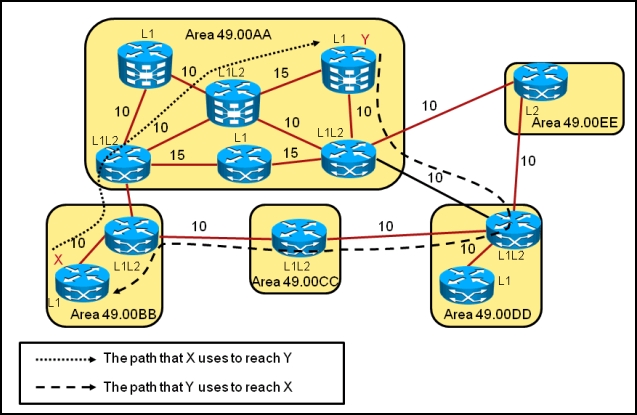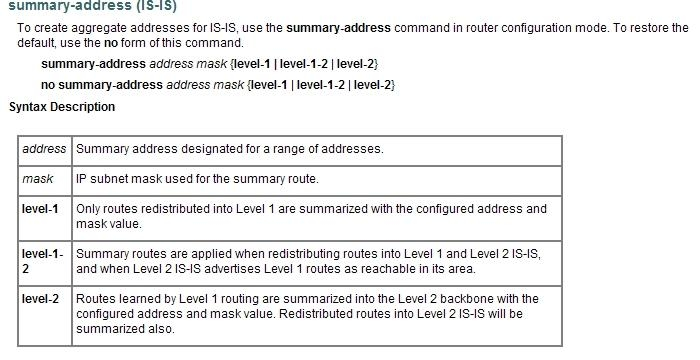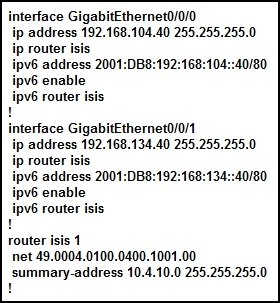Cisco® 642-883 Exam Practice Questions (P. 3)
- Full Access (191 questions)
- Six months of Premium Access
- Access to one million comments
- Seamless ChatGPT Integration
- Ability to download PDF files
- Anki Flashcard files for revision
- No Captcha & No AdSense
- Advanced Exam Configuration
Question #11
Refer to the topology diagram in the exhibit.

Which IS-IS feature could be implemented so that the return path for the packets from router Y in area 49.00AA to router X in area 49.00BB will use the more optimal path?

Which IS-IS feature could be implemented so that the return path for the packets from router Y in area 49.00AA to router X in area 49.00BB will use the more optimal path?
- AEnable route leaking to pass Level 2 information into the Level 1 routers.
- BChange the area 49.00AA type from a stub area to a regular area.
- CChange the IS-IS administrative distance on router Y inarea 49.00AA.
- DChange the IS-IS metric type from narrow to wide on all IS-IS routers.
Correct Answer:
A
http://www.cisco.com/application/pdf/paws/13796/route-leak.pdf
The ISIS routing protocol allows for a twolevel hierarchy of routing information. There can be multiple Level 1 areas interconnected by a contiguous Level 2 backbone. A router can belong to Level 1, Level 2, or both. The Level 1 linkstate database contains information about that area only. The Level 2 linkstate database containsinformation about that level as well as each of the Level 1 areas. An L1/L2 router contains both Level 1 and Level 2 databases. It advertises information about the L1 area to which it belongs into L2. Each L1 area is essentially a stub area. Packets destined for an address that is outside of the L1 area are routed to the closest L1/L2 router to be forwarded on to the destination area. Routing to the closest L1/L2 router can lead to suboptimal routing when the shortest path to the destination is through a different L1/L2 router.
Route leaking helps reduce suboptimal routing by providing a mechanism for leaking, or redistributing, L2 information into L1 areas. By having more detail about inter area routes, an L1 router is able to make a better choice with regard to which L1/L2 router to forward the packet.
A
http://www.cisco.com/application/pdf/paws/13796/route-leak.pdf
The ISIS routing protocol allows for a twolevel hierarchy of routing information. There can be multiple Level 1 areas interconnected by a contiguous Level 2 backbone. A router can belong to Level 1, Level 2, or both. The Level 1 linkstate database contains information about that area only. The Level 2 linkstate database containsinformation about that level as well as each of the Level 1 areas. An L1/L2 router contains both Level 1 and Level 2 databases. It advertises information about the L1 area to which it belongs into L2. Each L1 area is essentially a stub area. Packets destined for an address that is outside of the L1 area are routed to the closest L1/L2 router to be forwarded on to the destination area. Routing to the closest L1/L2 router can lead to suboptimal routing when the shortest path to the destination is through a different L1/L2 router.
Route leaking helps reduce suboptimal routing by providing a mechanism for leaking, or redistributing, L2 information into L1 areas. By having more detail about inter area routes, an L1 router is able to make a better choice with regard to which L1/L2 router to forward the packet.
send
light_mode
delete
Question #12
Refer to the exhibit.

Which two configuration options can be used to optimize the IS-IS network scenario? (Choose two.)

Which two configuration options can be used to optimize the IS-IS network scenario? (Choose two.)
- AChange the R1 and R2 IS type to Level 2.
- BChange the R1and R2 IS type to Level 1.
- CChange the gi0/0 interface IS-IS circuit type on R1 and R2 to Level 2 only.
- DChange the gi0/1 interface IS-IS circuit type on R1and R2 to Level 1.
- EChange the IS type for all the routers to Level-1-2.
- FChange the IS-IS network type for all the routers to point-to-point.
Correct Answer:
CD
CD
send
light_mode
delete
Question #13
The Cisco IOS XE Software summary-address router IS-IS configuration command can be used to send a summarized route into which IS-IS hierarchy?
- ALevel 1 only
- BLevel 2 only
- CLevel-1-2 only
- DLevel 1 or Level 2 or Level-1-2
Correct Answer:
D

D

send
light_mode
delete
Question #14
Refer to the Cisco IOS XE IS-IS configuration exhibit.

What are two problems with the configuration that are causing the IPv4, or the IPv6, or the IPv4 and IPv6 IS-IS operations to fail? (Choose two.)

What are two problems with the configuration that are causing the IPv4, or the IPv6, or the IPv4 and IPv6 IS-IS operations to fail? (Choose two.)
- AThe configuration is missing the interface gi0/0/0 and interface gi0/0/0 commands under router isis 1.
- BThe configuration is missing the address-family ipv4 unicast and address-familyipv6 unicast commands under router isis 1.
- CIPv6 unicast routing has not been enabled globally on the Cisco IOS XE router.
- DThe gi0/0/0 and gi0/0/1 interfaces are not participating in the router isis 1 routing instance.
- EMultitopology IS-IS must beenabled to support both IPv4 and IPv6.
- FAnother router isis instance must be enabled to support IPv6.
Correct Answer:
CD
http://www.cisco.com/en/US/docs/switches/metro/me3400/software/release/12.2_50_se/configuration/guide/swipv6.pdf
When using user-network interface (UNI) or enhanced network interface (ENI) ports for any
IPv6-related features, you must first globally enable IP routing and IPv6 routing on the switch by entering the ip routing ipv6 unicast-routing
CD
http://www.cisco.com/en/US/docs/switches/metro/me3400/software/release/12.2_50_se/configuration/guide/swipv6.pdf
When using user-network interface (UNI) or enhanced network interface (ENI) ports for any
IPv6-related features, you must first globally enable IP routing and IPv6 routing on the switch by entering the ip routing ipv6 unicast-routing
send
light_mode
delete
Question #15
In which network environment is IS-IS adjacency check important?
- Ain a multitopology environment where there are different instances of IS-IS running on the same router
- Bin an IPv4/IPv6 environment and running single-topology IS-IS
- Cwhen a level L1/L2 IS-IS router is neighboring with a Level 1 only or Level 2 only router
- Dwhen IS-IS neighbors are in an NBMA environment like over Frame Relay
- Ewhen IS-IS neighbors are in a broadcast environment like an Ethernet LAN
Correct Answer:
B

B

send
light_mode
delete
All Pages
